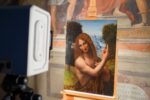Luisa Mè – Look at me!

Look at me!, oltre che audace e quasi arrogante richiesta di attenzione, è un invito che i Luisa Mè – duo di giovani artisti italiani che presentano il proprio lavoro al pubblico per la prima volta – rivolgono allo spettatore affinché non si limiti a una immediata e istintiva partecipazione.
Comunicato stampa
Look at me!, oltre che audace e quasi arrogante richiesta di attenzione, è un invito che i Luisa Mè – duo di giovani artisti italiani che presentano il proprio lavoro al pubblico per la prima volta - rivolgono allo spettatore affinché non si limiti a una immediata e istintiva partecipazione.
Un’energia prorompente trasforma situazioni di pace apparente in veri e propri combattimenti che costringono le figure in contorsioni innaturali e dolorose. I personaggi si dimenano a tal punto da sembrare voler uscire dalla tela spingendo con forza gambe e piedi sui confini del telaio. Allo stesso tempo tuttavia questo perimetro diventa un appoggio saldo per poter attivare l’azione violenta e necessaria ricreata all’interno della composizione. Anche le sinuose sculture in resina e creta, contraddicendo quell’immobilità che dovrebbe caratterizzarne la natura, appaiono animate da una volontà di ribellione evidente nella pressione verso pavimento quasi a precedere la fuga.
La costante ricerca di consolazione e il desiderio di trovare rifugio dietro bellezze rassicuranti danno vita ad una malattia che inaspettatamente cresce in forma di becchi appuntiti sui volti dei personaggi che si trasformano in figure semi-umane dalla sorprendente intensità iconica. Personaggi antropomorfi decorati con lunghe piume colorate, come in ‘Orano’ o ‘Per via del sole’, sembrano divinità di qualche religione primitiva catturate nell’atto di mettere in pratica un rituale.
Al tempo stesso i personaggi dei dipinti hanno fattezze simili a quelle di apostoli o martiri che formano immagini iconiche riconducibili alla cristianità e ricordano le figure dormienti dei capolavori del Mantegna e del Bellini. L’omaggio ai maestri della storia dell’arte sacra italiana, anche nella gamma di colori vivaci distribuiti su tutta la scena, diventa opportunità per prendere in prestito dall’iconografia religiosa quella potenza visiva necessaria per coinvolgere emotivamente lo spettatore nel tormento di figure innocenti.
L’inquietudine che pervade le situazioni raffigurate è poi esasperata dalla rappresentazione del moshpit, quell’area sotto il palco dei concerti hard rock o heavy metal in cui i fan più agitati danzano e si spingono con energia fino ai limiti della violenza. Nei quadri dei Luisa Mè il moshpit trasforma immagini serene, come una spiaggia o una serenata, in azioni violente, mostrando così il lato oscuro che si cela dietro il piacevole e confortante. Nel caso di ‘Look at me! (Sunset)’, ad esempio, la contorsione dei corpi e il pestaggio di gruppo davanti a un tramonto danno vita a un vero e proprio martirio che diventa anche allusione a scene di brutalità e violenza a cui assistiamo e a alle quali siamo ormai tristemente assuefatti.
Luisa Mè
Look at me!
16 December 2017 – 26 January 2018
Opening 15 December, 6pm
Via Ripense 6, Rome
[email protected]
In addition to being a bold and almost arrogant call for attention, Look at me! is an invitation to go beyond an immediate and instinctive participation that Luisa Mè - a duo of young Italian artists who present their work to the public for the first time – address to the observer.
An overwhelming energy transforms apparently peaceful situations into virtual struggles that force the figures into unnatural and painful contortions. The characters writhe to such an extent that they look like they are literally trying to escape from the canvas, strenuously pushing their legs and feet onto the boundaries of the frame. At the same time, this perimeter becomes a solid support for the activation of those violent and necessary actions within the composition. In contradiction to the immobility that should characterize their nature, the curvaceous sculptures in resin and clay also appear to be animated by a desire for rebellion which is evident in the visual downward pressure towards the floor that nearly precedes their escape.
The constant search for consolation and the desire to find shelter behind areassuring beauty provoke an illness that unexpectedly appears as sharp beaks on the face of the characters, transforming them into semi-human figures with a surprisingly iconic intensity. Anthropomorphic characters decorated with long colored feathers, such as in ‘Orano’ and ‘Per via del sole’, appear like divinities from a primitive religion captured in the act of practicing a ritual.
At the same time, their features are similar to those of the apostles or martyrs, thus generating iconic images that can be traced back to Christianity and recall the dormant figures of the masterpieces of Mantegna and Bellini. This tribute to the masters of the history of Italian sacred art, also evident in the lively color range distributed throughout the scene, becomes an opportunity to borrow that visual power from religious iconography that is fundamental to engage emotionally the observer in this torment of innocent figures.
The anxiety pervading the situations depicted in the artworks is heightened by the representation of the moshpit, that area under the stage of hard rock or heavy metal concerts where the most agitated fans dance and push with an intensity verging on violence. In the paintings of Luisa Mè, the moshpit turns serene images, such as a beach or a serenade, into violent actions unveiling the dark side that lies behind the pleasant and the comforting. In the case of 'Look at me! (Sunset), for example, the contortion of the bodies and the group thrashing at sunset lead to a veritable martyrdom, alluding to the scenes of brutality that we witness very often and to which we are sadly
accostumed.



